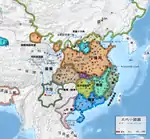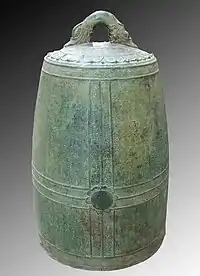Timeline of early independent Vietnam
This is a timeline of Early Independent Vietnam, covering the period of Vietnamese history from the rise of the Tĩnh Hải circuit ruled by Khúc clan (r. 905–923/930) to the kingdom of Đại Việt ruled by the house of Lê (980–1009).

Ngô dynasty ruling Tĩnh Hải circuit in 938
10th century
| Year | Date | Event |
|---|---|---|
| 905 | A Vietnamese noble, Khúc Thừa Dụ of the Khúc clan is elected as the jiedushi governor of Tĩnh Hải circuit | |
| 907 | Khúc Thừa Dụ's son, Khúc Hạo succeed the title jiedushi and is recognized by Zhu Quanzhong[1] | |
| 911 | Khúc Hạo's son, Khúc Thừa Mỹ brings to Later Liang dynasty's court 500 Vietnamese bananas, seafoods, jades, gold and silver objects as tributes[2] | |
| 917 | Khúc Thừa Mỹ continue succeeding the governor of Annam | |
| 930 | Southern Han invades Annam and removes the Khúc clan from power; Khúc Thừa Mỹ lives out the rest of his days at the Southern Han court[3] | |
| 931 | Dương Đình Nghệ expels Southern Han from Đại La and declares himself governor[3] | |
| 937 | Dương Đình Nghệ is murdered by his subject, Kiều Công Tiễn. Kiều Công Tiễn calls Southern Han for military assistance[4] | |
| 938 | December | Battle of Bạch Đằng: Southern Han's fleet led by Liu Hongcao to subdue Annam is defeated on Bạch Đằng River by Vietnamese general Ngô Quyền[5] |
| 939 | 1 February | Ngô Quyền establishes his monarchy government at Cổ Loa Citadel, known in Vietnamese history texts as the Ngô dynasty[4] |
| 944 | 14 February | Ngô Quyền dies; his son Ngô Xương Ngập is ousted by Dương Tam Kha, who seizes the throne for himself[6] |
| 950 | Dương Tam Kha is deposed by Ngô Xương Văn, who shares power with his brother Ngô Xương Ngập in a dual monarchy[6] | |
| 954 | Ngô Xương Ngập dies, after which Ngô Xương Văn declares himself a vassal of Southern Han[6] | |
| 965 | Ngô Xương Văn dies in battle against the rebellion of Đường Nguyễn; his son Ngô Xương Xí succeeds him but fails to retain control over the realm, resulting in the Anarchy of the 12 Warlords[6] | |
| 968 | Duke Đinh Bộ Lĩnh reunites the country under the Đinh dynasty and ends the Anarchy of the 12 Warlords[6] | |
| 972 | Đại Cồ Việt's independence is recognized by Song China, establishing the nominate tributary relation[7] | |
| 979 | October | Đinh Bộ Lĩnh is assassinated by a eunuch and his infant son Đinh Phế Đế succeeds him; Dương Vân Nga becomes regent, however under the pressure of an impending Song dynasty invasion, she threw her support behind the commander-in-chief Lê Hoàn[6] |
| 980 | July | General Lê Hoàn replaces the house of Đinh and become the new ruler of Đại Cồ Việt |
| 981 | Battle of Bạch Đằng (981): Song dynasty invades Đại Cồ Việt with initial success but is ambushed and the campaign ends with Lê Hoàn accepting Song suzerainty[8] | |
| 982 | Champa detains envoys from Đại Cồ Việt, resulting in an invasion by Lê Hoàn, and the death of the Cham king Paramesvaravarman I and the plundering of its capital, Vijaya[9] | |
| 983 | King Lê Hoàn issues the construction of the canal through 4 provinces Ninh Bình, Thanh Hóa, Nghệ An and Hà Tĩnh, as known as Lê Canal (Sông nhà Lê) | |
| 986 | A Vietnamese merchant in Indrapura named Lưu Kỳ Tông (Lieou Ki-Tsong) takes the throne of Cham king Indravarman IV[10] | |
| 988 | Cham people launch revolution try to overthrow Lưu Kỳ Tông but fails. Many Cham take refugees in Hainan Island, China | |
| 989 | Lưu Kỳ Tông dies | |
| 990 | Song China sends emissary to Hoa Lư[7] | |
| 995 | Summer | Vietnamese troops and warships attacked Chinese border towns[7] |
| 997 | Song Emperor gives Lê Hoàn the second title King of Nanping (南平王) in addition with King of Giao Chỉ (交趾郡王)[7] |
11th century
| Year | Date | Event |
|---|---|---|
| 1005 | Lê Hoàn dies, causing a succession dispute that saw Lê Trung Tông killed after ruling for only 3 days; Lê Long Đĩnh succeeds him as new ruler of the Vietnamese[11] | |
| 1006 | Lê Long Đĩnh receives hundred of Mahayana Buddhist sutras, Taoist books, Classic literature from Song China and translate into Vietnamese[12] | |
| 1007 | Lê Long Đĩnh sends tributes to Song China, and receives back clothes, sutras, buckle belts[7] | |
| 1009 | Lê Long Đĩnh dies from hemorrhoids; military leader Lý Công Uẩn replaces the house of Lê and establishes the House of Lý[13] |
Gallery
 Map of China and Vietnam during 951–960. Annam locates in the south, bordered by light purple line.
Map of China and Vietnam during 951–960. Annam locates in the south, bordered by light purple line..jpg.webp) Coins Thái Bình Hưng Bảo issued by emperor Đinh Tiên Hoàng in 970, the first Vietnamese native cash coins
Coins Thái Bình Hưng Bảo issued by emperor Đinh Tiên Hoàng in 970, the first Vietnamese native cash coins Nhật Tảo bronze bell casted in 948 by Hạ Từ Liêm blacksmith, contains Buddhist inscriptions and some earliest Vietnamese Nôm script characters
Nhật Tảo bronze bell casted in 948 by Hạ Từ Liêm blacksmith, contains Buddhist inscriptions and some earliest Vietnamese Nôm script characters Ceramic bowl originated from Abbasid Caliphate, dated 940s in Hanoi
Ceramic bowl originated from Abbasid Caliphate, dated 940s in Hanoi.jpg.webp)
Citations
- Juzheng 1995, p. 53.
- Juzheng 1995, p. 100.
- Taylor 2013, p. 45.
- Taylor 2013, p. 46.
- Zizhi Tongjian, vol. 280.
- Taylor 2013, p. 47.
- History of Song, vol. 488
- Walker 2012, p. 211-212.
- Taylor 2013, p. 56.
- Champa : Vương triều Indrapura (thế kỳ thứ IX-XI)
- Taylor 2013, p. 58.
- Khâm định Việt sử Thông giám cương mục, Main/vol. 2
- Taylor 2013, p. 60.
References
- Juzheng, Xue (1995), Old History of the Five Dynasties, Zhonghua Book Company, ISBN 7101003214
- Crespigny, Rafe (2007), A Biographical Dictionary of Later Han to the Three Kingdoms (23-220 AD), Brill
- Taylor, Jay (1983), The Birth of the Vietnamese, University of California Press
- Taylor, K.W. (2013), A History of the Vietnamese, Cambridge University Press
- Twitchett, Denis (2008), The Cambridge History of China 1, Cambridge University Press
- Walker, Hugh Dyson (2012), East Asia: A New History, AuthorHouse
- Xiong, Victor Cunrui (2009), Historical Dictionary of Medieval China, United States of America: Scarecrow Press, Inc., ISBN 978-0810860537
This article is issued from Wikipedia. The text is licensed under Creative Commons - Attribution - Sharealike. Additional terms may apply for the media files.